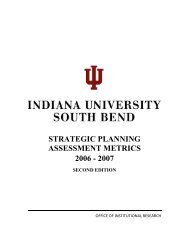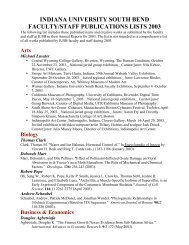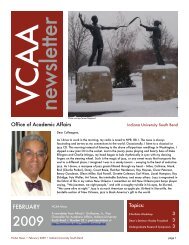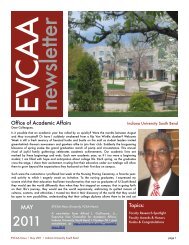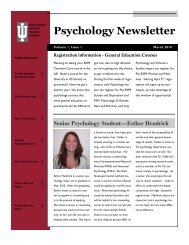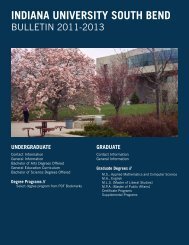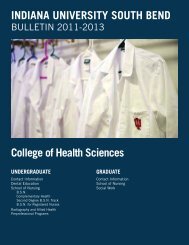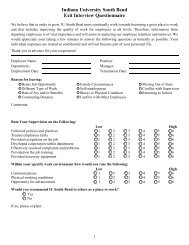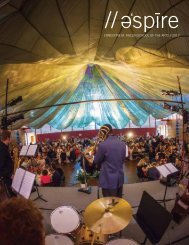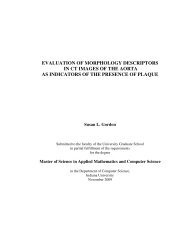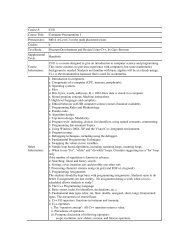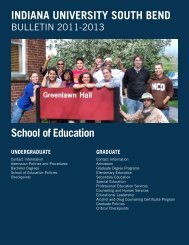Current version - Indiana University South Bend
Current version - Indiana University South Bend
Current version - Indiana University South Bend
You also want an ePaper? Increase the reach of your titles
YUMPU automatically turns print PDFs into web optimized ePapers that Google loves.
IU SOUTH BEND COURSE DESCRIPTIONS 4275<br />
AST-N 190 The Natural World (3 cr.)<br />
Introduces students to the methods and logic<br />
of science, and helps them understand the<br />
importance of science to the development<br />
of civilization and the contemporary world.<br />
Provides a context within which to evaluate<br />
the important scientific and technological<br />
issues of modern society. Interdisciplinary<br />
elements.<br />
AST-n 390 introduction to archaeology (3 cr.)<br />
Explores an important scientific<br />
or technological issue in modern<br />
society. Applies scientific methods and<br />
interdisciplinary perspectives in an<br />
examination of the subject. Investigates<br />
the broader implications and ethical<br />
dimensions of scientific research and<br />
technological advancement.<br />
BIOL: Biology<br />
See ANAT, MICR, PHSL, and PLSC for additional<br />
biological sciences courses.<br />
BIOL-B 300<br />
VASCULAR PLANTS (3-4 cr.)<br />
P: BIOL-L 101, BIOL-L 102. Lecture and<br />
laboratory. Survey of the plant kingdom,<br />
including the anatomy, classification,<br />
ecology, evolution, and morphology of<br />
representative families. I (even years)<br />
BIOL-L 100 Humans and the Biological World<br />
(1-5 cr.)<br />
Lecture and laboratory. For non-science<br />
majors. Credit allowed for only one of<br />
BIOL-L 100, BIOL-L 104, BIOL-T 100,<br />
and PHSL-P 130. Credit not allowed<br />
toward a biology major. Principles of<br />
biological organization from molecules<br />
through cells and organisms. Emphasis<br />
on processes common to all organisms,<br />
with special reference to humans. I, II, S<br />
BIOL-L 101 Introduction to Biological Sciences<br />
1 (4-5 cr.)<br />
P: MATH Level 4 or higher by<br />
placement examination or completion of<br />
MATH-M 107. Lecture and laboratory.<br />
Fundamental principles of biology for<br />
students considering a career in biological<br />
sciences. Principles of genetics, evolution,<br />
ecology, and diversity. I, II<br />
BIOL-L 102 Introduction to biological Sciences<br />
2 (4-5 cr.)<br />
P: MATH Level 4 or higher by placement<br />
examination or completion of MATH-M<br />
107, one year of high school chemistry<br />
or one semester of college chemistry. R:<br />
BIOL-L 101. Fundamental principles of<br />
biology for students considering a career<br />
in biological sciences. Cell structure and<br />
function, bioenergetics, and organismal<br />
morphology and physiology. I, II<br />
BIOL-L 104 introductory biology lectures (3 cr.)<br />
For non-science majors. Credit allowed<br />
for only one of BIOL-L 100, BIOL-L 104,<br />
BIOL-T 100, and PHSL-P 130. Credit<br />
not allowed toward a biology major.<br />
Principles of biological organization from<br />
molecules through cells and organisms.<br />
Emphasis on processes common to all<br />
organisms, with special reference to<br />
humans. I, II<br />
BIOL-L 211 Molecular Biology (3 cr.)<br />
P: BIOL-L 102, CHEM-C 105, CHEM-C<br />
106. Structure and function of DNA and<br />
RNA. DNA replication, mechanisms of<br />
mutation and repair. The genetic code,<br />
transcription, and translation. Introduces<br />
bacteriophages, plasmids, and the<br />
technology of recombinant DNA. I<br />
BIOL-L 220 BIOSTATISTICS (3 cr.)<br />
P: Mathematics Level 5, BIOL-L 101,<br />
BIOL-L 102. Fundamentals of statistics<br />
intended to equip students with skills<br />
needed to understand and draw statistical<br />
inferences from biological data. Will<br />
include data reduction, probability,<br />
hypothesis testing, correlation,<br />
regression, and analysis of variance.<br />
BIOL-L 280 INTRODUCTION TO BIOINFORMATICS (3 cr.)<br />
P: Mathematics Level 5, one semester<br />
college biology. Topics may include<br />
analysis of DNA and protein sequences,<br />
algorithms used in computational<br />
biology, sequence alignments, biological<br />
databases, predictive methods for RNA<br />
and protein structures, phylogenetic<br />
analysis, computational approaches<br />
to comparative genomics, analysis of<br />
microarray expression data, proteomics<br />
and protein identification. I (even years)<br />
BIOL-L 304 Marine Biology (3 cr.)<br />
P: BIOL-L 101, one semester of college<br />
chemistry. An introductory lecture<br />
course covering principles, concepts,<br />
and techniques of marine and estuarine<br />
biology. II (even years)<br />
BIOL-L 308 Organismal Physiology (5 cr.)<br />
P: BIOL-L 101, BIOL-L 102, BIOL-L 211,<br />
CHEM-C 106. R: BIOL-L 312. Structural<br />
and functional aspects of regulative<br />
processes in animals; detection of the<br />
environment, integrative functions,<br />
reproduction. Laboratory deals with<br />
representative experiments on animal<br />
physiological processes. I



